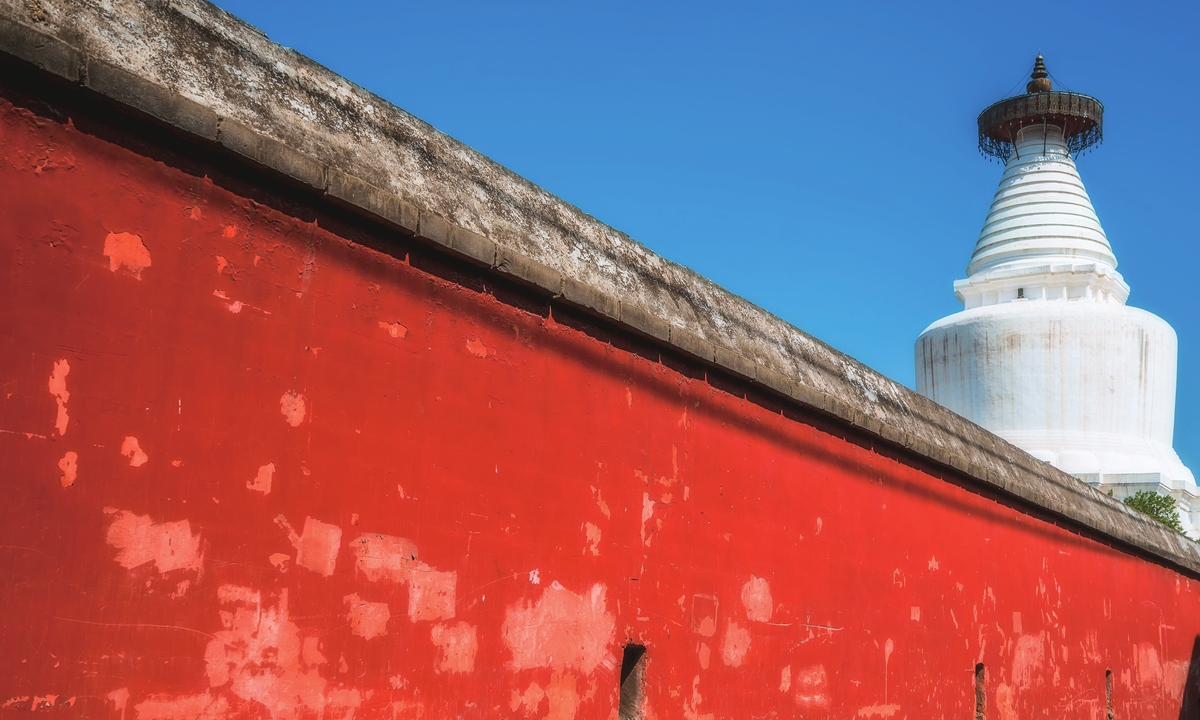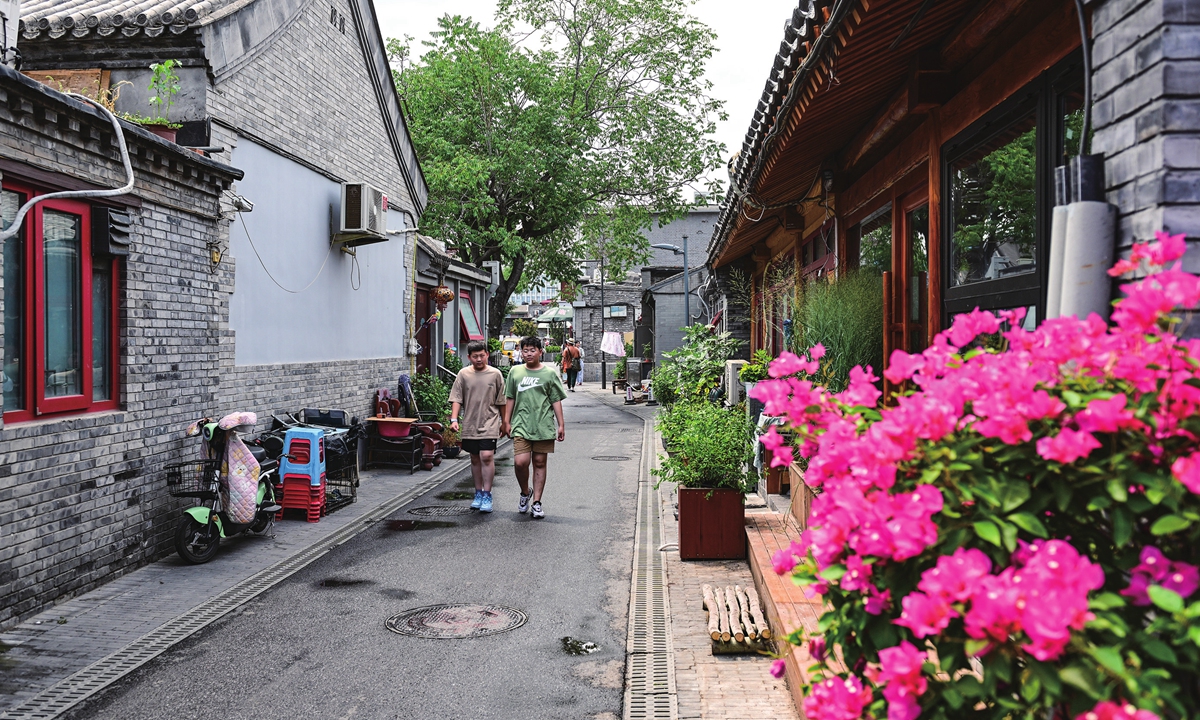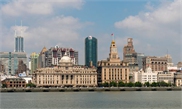ARTS / CULTURE & LEISURE
Exploring the capital through the latest trendy pastime

White Pagoda of the Miaoying Temple Photo: VCG
City walk, a unique way to experience urban culture and lifestyle, has been gaining popularity among young people in China. Participants take low-carbon, low-cost and relaxing walks along distinct city routes, exploring old buildings, specialty shops, enjoying a cup of coffee, and savoring local snacks.
On China's lifestyle-sharing platform Xiaohongshu, more than 400,000 posts related to the key words "city walk" are posted, including city walk outfits and essentials, recommended routes and walk experiences. Some individuals even look for companions to form a city walk group.
Traditionally, city walks were led by professional guides, following planned routes through city neighborhoods to gain insights into local history, culture, and architecture. However, recent versions of city walks in China have taken on a more casual approach. They involve aimlessly roaming around the city, visiting iconic spots, and capturing moments.
As a post defined it on Xiaohongshu, "Wandering aimlessly in the city, going straight at green lights, turning at red lights, experiencing the vitality of the city on foot, and discovering hidden gems and unique local vibes." In essence, it's simply "walking in the city."
Beijing, a city that blends tradition and modernity, has become one of the hottest destinations for city walk enthusiasts. Exploring the historic hutongs allows walkers to immerse themselves in the charm of the city's history while experiencing the bustling life of its inhabitants. Meanwhile, it also offers a plethora of gastronomic delights, creative boutique shops and fashionable destinations.

A hutong, small alley near the White Pagoda of Miaoying Temple in Xicheng district, Beijing Photo: VCG
A life on foot
Roaming along the narrow alleys in central Beijing is an especially good opportunity to have a face-to-face conversation with the city's past, which has 870 years of history being a capital since ancient China.
The architecture within the city has been well preserved in city center: in the area inside the city's second ring road (Beijing's urban area is divided by a total of six square ring roads starting from the center), the towering skyscrapers are soon replaced by low bungalows, temples, pagodas and other kinds of cultural architectural complexes which date back to at least hundreds of years ago.
The uniqueness of a Beijing city walk cannot be described fully without mentioning the Beijing Central Axis, a 7.8-kilometer-long road splitting the city into east and west halves, as city plans evolved with the axis as their center.
Guan Ping, a Beijing-based tour guide and a history lover, told the Global Times that sometimes he gathers some of his friends to have an "immersive walk" starting from the southern side of the Axis.
"We normally start from Tianqiao, then walk up north," Guan said, "I can't tell you the exact itinerary of our activity, but we normally end up climbing on top of the hill inside Jingshan Park, right at the north of the Palace Museum."
Guan believes that by overlooking the city from the hill, people can "feel a real connection with this city, and truly understand why this Central Axis is so important."
"It all started with a small circle of my friends, but in recent months more and more strangers joined us. You could say it is a planned city walk, but it is something different from what I used to do as a tour guide, our activity doesn't charge the participants," said Guan.
The popularity of the Beijing's Central Axis secured more visitors' interest in Beijing's historical vibe than ever before. Two kilometers straight from Jingshan Park in the west, the White Pagoda of the Miaoying Temple built as early as the Yuan Dynasty (1271-1368) becomes another city walk starting point for many.
After visiting the temple, people can either rest themselves in cafes in small open air yards or watch the pagoda from a completely different angle by roaming among the small alleys outside the temple.
In this Tibetan Buddhist temple it is possible to find traces of history and cultural fusion at every turn.
Additionally, only by walking one kilometer eastward, at the end of a tree-shaded street near the Beihai Park, Xishiku Church, completed in 1888, offers an atmosphere filled with hymns and peaceful music. From here the city vibe changes again.

Liangma River in Chaoyang district Photos: VCG
Hubs of influencers
From the demolition of the fence around Chaoyang Park in eastern Beijing to the construction of street gardens near Sanlitun business center, Beijing urban construction is also moving in a pedestrian-friendly direction, another feature that makes city walk in Beijing so special.
Just in the first half of this year, the renovation work in Sanlitun, Chaoyang district, was completed. The nearby Sanlitun SOHO is now an area filled with street vendors selling handmade jewelry and various snacks like barbeque and lemon tea at more affordable prices than mall stores.
What surprised many people was a brand-new Liangma River, which has been renovated as early as 2021, which runs through the east part of the city connecting different areas of Chaoyang Park.
The river banks rank top among the most popular routes for people to relax, transforming Liangma River into the "Seine of Beijing."
The riversides adorned with lush reeds and people can be seen swimming, paddling on boards, or cleaning the river's water. Along the pedestrian walkways, there are dog walkers, picnickers, fishers, and a variety of street vendors, including a vendor selling colorful handmade acrylic nails.
Moving toward the embassy district, lined with flourishing trees, the atmosphere is quieter compared to that around the Liangma River. Here are located embassies of various countries and headquarters of institutions.
After walking for about two kilometers and passing by many cafes and eateries, one will arrive at some of the favorite destinations for young tourists and locals: Sanlitun and Taikoo Li.
Such relaxing city walks prove time and again they are the perfect choice for unwinding from a long work week.

